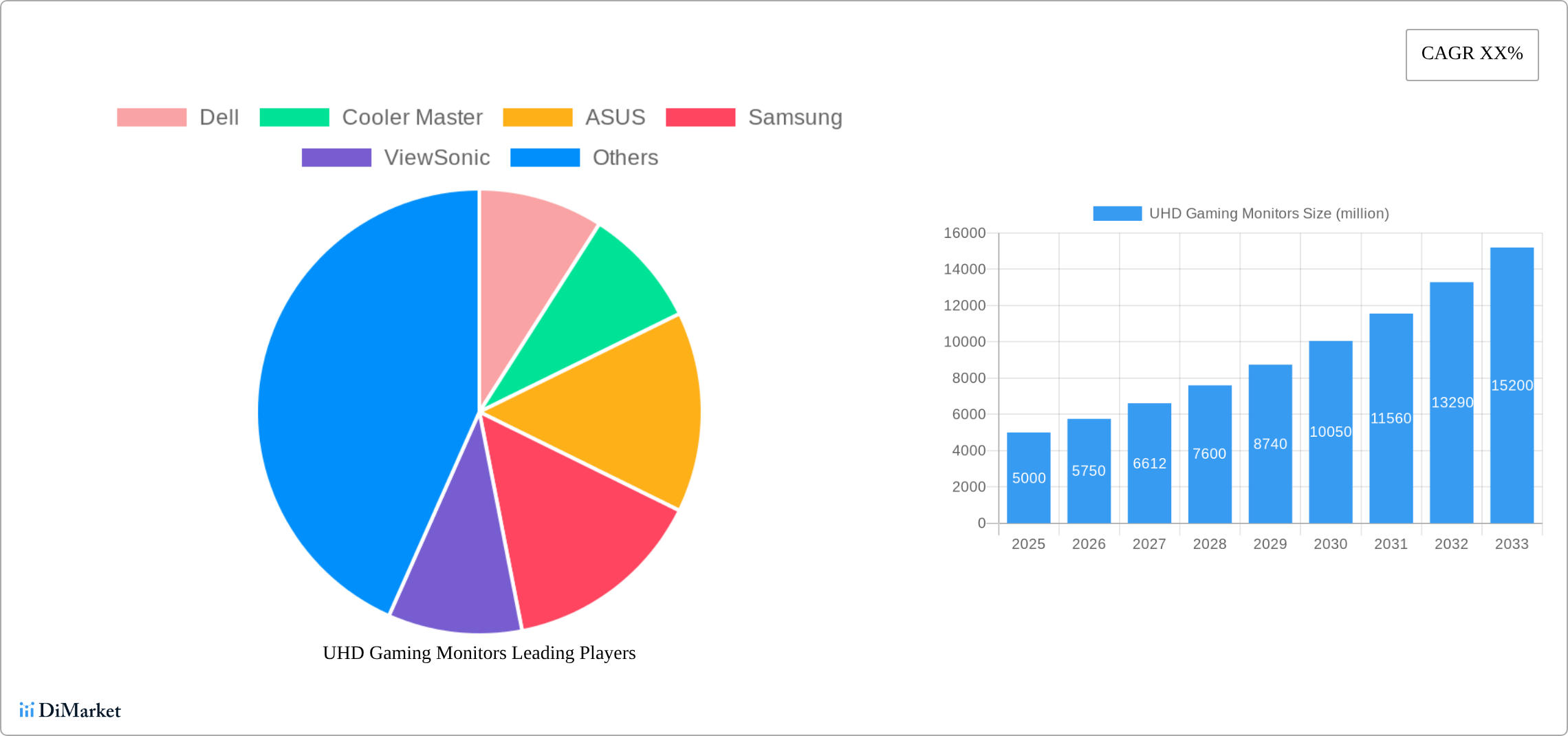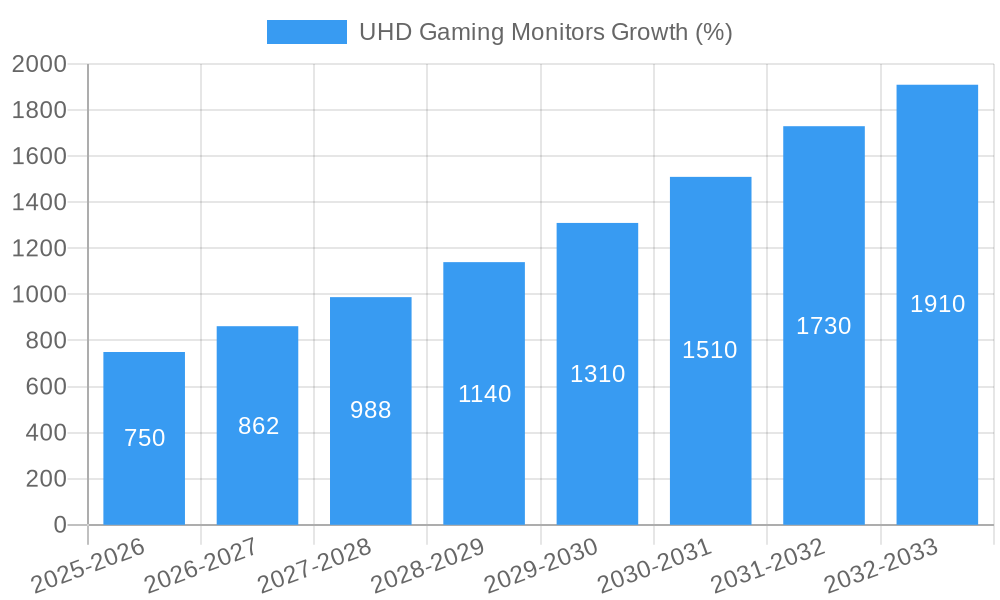The UHD gaming monitor market is experiencing robust growth, driven by increasing demand for immersive gaming experiences and advancements in display technology. The market, estimated at $5 billion in 2025, is projected to exhibit a Compound Annual Growth Rate (CAGR) of 15% from 2025 to 2033, reaching an estimated $15 billion by 2033. This expansion is fueled by several key factors. The rising popularity of esports and competitive gaming is a significant driver, pushing consumers towards higher-resolution displays for enhanced visual clarity and competitive advantage. Technological advancements, such as the introduction of higher refresh rates (144Hz and above) and HDR support in UHD monitors, further enhance the gaming experience, driving demand. Furthermore, the increasing affordability of UHD monitors and the growing penetration of high-speed internet access are contributing to market expansion. Major players like Dell, Cooler Master, ASUS, Samsung, ViewSonic, Philips, Acer, Gigabyte Technology, LG, and Sony are actively competing in this space, introducing innovative products and features to cater to the evolving needs of gamers.
The market faces certain restraints, primarily related to the relatively higher price point of UHD gaming monitors compared to lower-resolution alternatives. However, this barrier is gradually diminishing as technology matures and production costs decrease. Segmentation within the market is largely driven by screen size, refresh rate, and panel technology (e.g., IPS, VA, TN). Regional variations exist, with North America and Asia-Pacific expected to dominate the market due to higher gaming adoption rates and disposable incomes. However, increasing gaming penetration in European and other regions promises further market expansion in the coming years. Future growth will depend on the continued innovation in display technologies, including advancements in mini-LED backlighting, OLED, and potentially even micro-LED, further enhancing image quality and reducing power consumption. The ongoing development of virtual reality (VR) and augmented reality (AR) technologies could also present new opportunities for UHD gaming monitors in the long term.
UHD Gaming Monitors Concentration & Characteristics
The UHD gaming monitor market, valued at several million units in 2024, exhibits a moderately concentrated landscape. Key players like Dell, ASUS, Samsung, and LG hold significant market share, though smaller players like Cooler Master, ViewSonic, Philips, Acer, Gigabyte Technology, and Sony also contribute significantly. Innovation is heavily focused on higher refresh rates (above 144Hz), improved response times (sub-1ms), HDR support, and advanced display technologies like mini-LED and OLED.
Concentration Areas:
High-Refresh Rate Panels: A significant portion of market concentration stems from companies competing in offering the highest refresh rates and lowest response times.
Advanced Panel Technologies: Mini-LED and OLED are emerging as key battlegrounds for market share, with companies investing heavily in R&D.
High-Resolution Displays: While UHD is the focus, future concentration will likely shift to even higher resolutions, driving further innovation.
Characteristics:
High Innovation: The market is characterized by rapid technological advancements, with new features and technologies constantly being introduced.
Impact of Regulations: Regulations related to energy efficiency and emissions influence design and manufacturing processes.
Product Substitutes: Large, high-quality televisions can serve as a substitute, albeit with different usability characteristics.
End-User Concentration: The primary end-users are gamers, professionals in fields like video editing, and enthusiasts seeking superior visual experiences.
Level of M&A: Moderate levels of mergers and acquisitions are seen as companies seek to expand their product portfolios and market reach.
UHD Gaming Monitors Trends
The UHD gaming monitor market is experiencing robust growth driven by several key factors. The increasing popularity of esports and competitive gaming fuels the demand for high-performance displays with superior refresh rates and response times. Furthermore, the rise of high-fidelity gaming and the increasing availability of games supporting higher resolutions are key drivers. Technological advancements such as mini-LED backlighting, which enables higher contrast ratios and improved local dimming, and the emergence of OLED panels, offering perfect blacks and vibrant colors, are transforming the landscape. Consumers are increasingly prioritizing immersive gaming experiences, leading to a strong demand for larger screen sizes and wider aspect ratios. The integration of adaptive sync technologies like G-Sync and FreeSync minimizes screen tearing and stuttering, providing smoother gameplay and further enhancing the user experience. The growth in the professional content creation sector also contributes, with designers and video editors requiring high-resolution displays for accurate color reproduction and detailed work. Finally, the continuous decrease in the price of UHD panels makes this technology more accessible to a broader consumer base. Within the forecast period (2025-2033), this trend is projected to continue, with substantial growth driven by the factors outlined above. However, challenges remain, including the higher cost of advanced technologies and potential supply chain disruptions. Despite these challenges, the market demonstrates a sustained positive trajectory with projections showing millions of units sold annually by 2033.
Post time: Jun-16-2025



